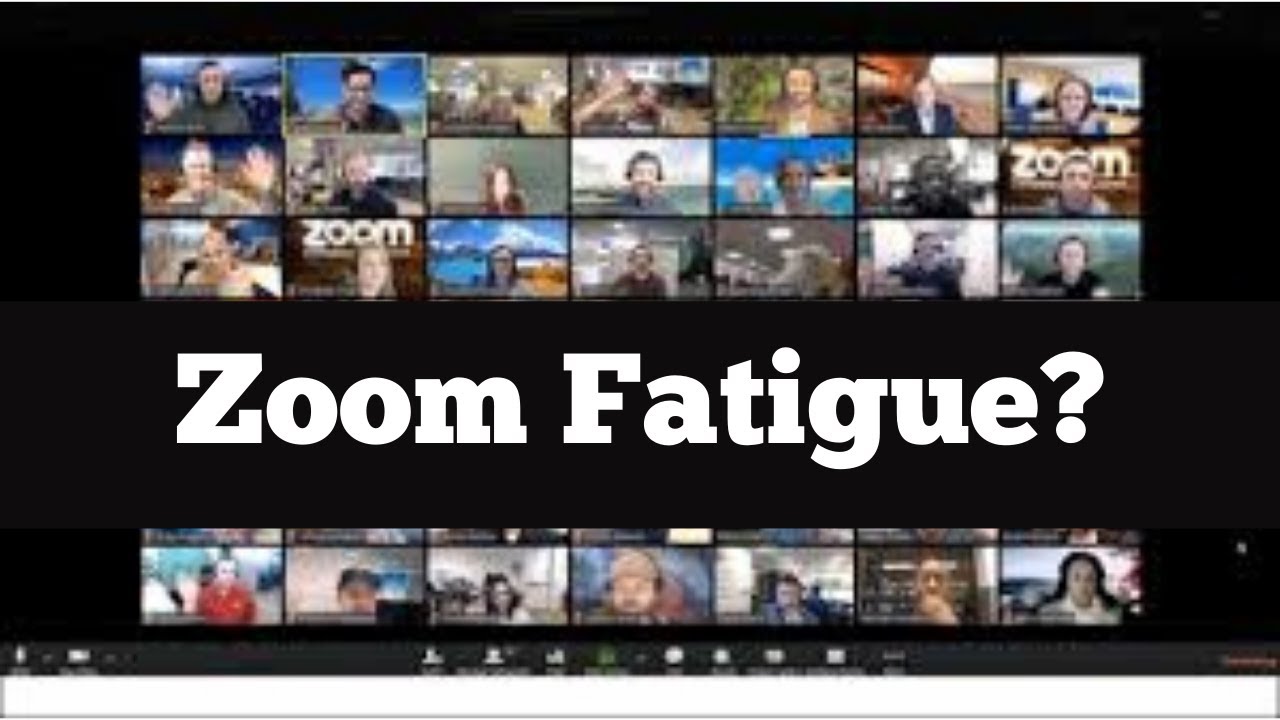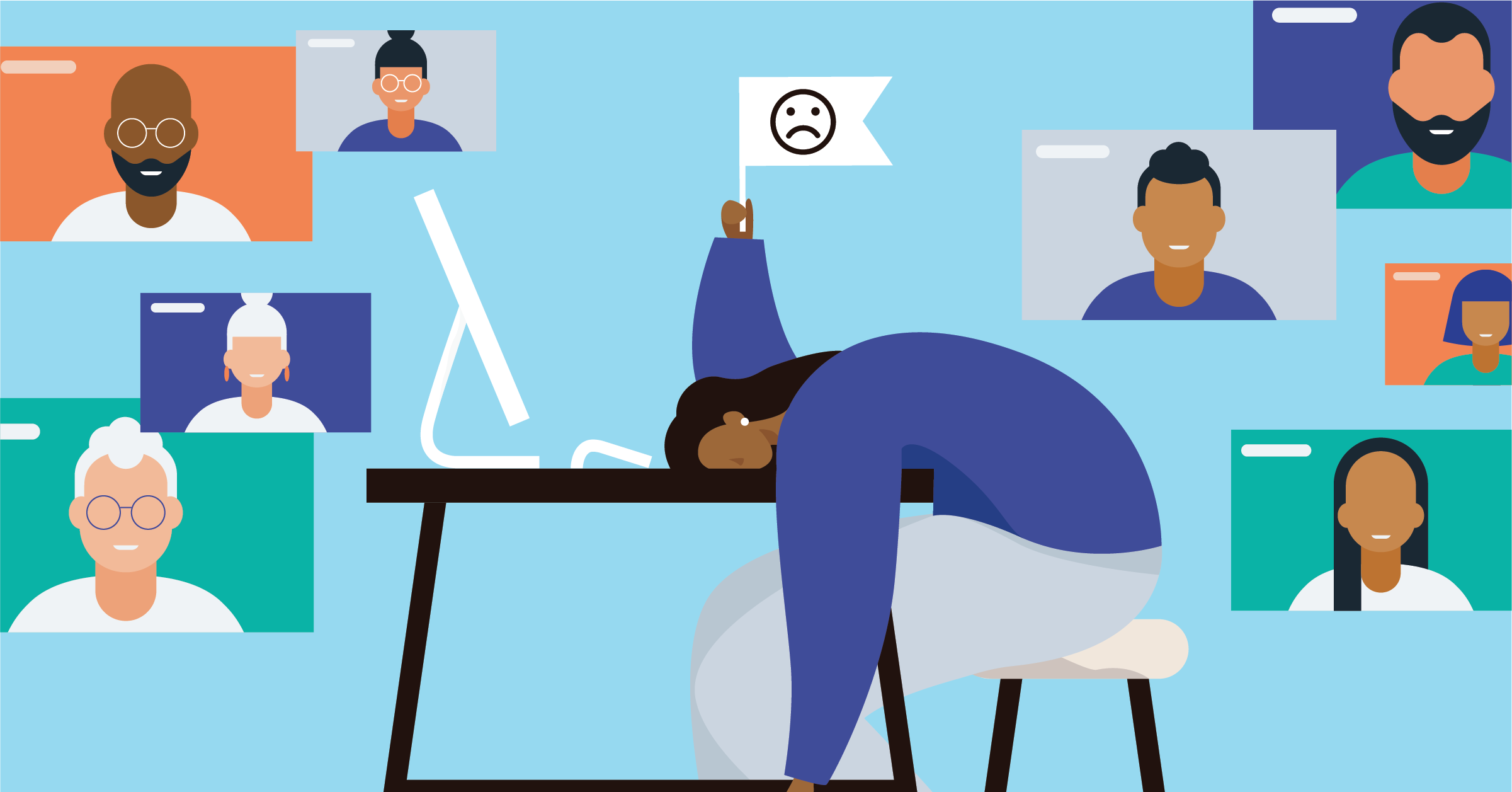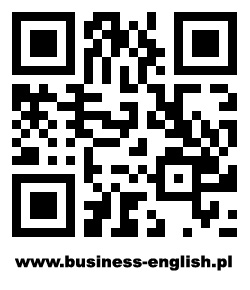Zoom Fatigued? So Are We!
 It used to be a half-jocular expression to vent one’s dissatisfaction with the relentless barrage of online-only meetings… Most of them could have been a simple e-mail exchange, after all! Since the pandemic struck, Zoom fatigue has become more than a light-hearted musing on the nature of our teleconference-rich business lives…
It used to be a half-jocular expression to vent one’s dissatisfaction with the relentless barrage of online-only meetings… Most of them could have been a simple e-mail exchange, after all! Since the pandemic struck, Zoom fatigue has become more than a light-hearted musing on the nature of our teleconference-rich business lives…

Well, it’s a very real thing now, supported by growing body of evidence. Researchers such as assistant professor Andrew Franklin over at Norfolk State University point to a lot of data proving what was previously supported by anecdotal evidence at best. “There’s a lot of research that shows we actually really struggle with this,” he says, explaining that there are actual psychological mechanisms at work that contribute to what is fast-becoming a new medically accepted condition. If you also feel intellectually and emotionally depleted owing to chatting live on camera over the Internet, you are not alone.

Zoom fatigue has been spreading for a variety of objectively verifiable reasons. One important part that is missing from typical calls is non-verbal communication – key to understanding emotions and attitudes of the person you are talking to. “For somebody who’s really dependent on those non-verbal cues, it can be a big drain not to have them,” offers Franklin. The quality of video, audio and size of screen all negatively impact the ability to comprehend the interlocutor on many levels. Our brains are wired to perceive social interactions through many more channels than just auditory and visual. It doesn’t help that multiple presenters are all vying for one’s attention during a call. “We’re engaged in numerous activities, but never fully devoting ourselves to focus on anything in particular,” says the professor, suggesting that multitude of distractors and large number of concurrent activities that a typical video call demands can tax one’s cognitive abilities.

Professor Jeremy Bailenson from Stanford Virtual Human Interaction Lab echoes these views. COVID-19 is certainly to blame, according to him, as we are reliant more and more on virtual-first working environment, even with vaccines and laxer restrictions in many countries. He suggests there are 4 main reasons for the new syndrome.
One reason for the social anxiety that many are feeling is the extensive close-up eye contact. „When you’re standing up there and everybody’s staring at you, that’s a stressful experience,” he states. Minimizing the size of your counterpart’s face on screen can be one potential solution, as is increasing distance to screen by putting a keyboard between oneself and the display.
The second important factor to consider is seeing oneself speaking in real time. This mirror effect is particularly draining. Bailenson explains that „if somebody was following you around with a mirror constantly – so that while you were talking to people, making decisions, giving feedback, getting feedback – you were seeing yourself in a mirror, that would just be crazy.” How lucky, then, that there is a very simple way of dealing with this. Just turn off your own view during the call!

Third on the list is restricted movement during telecommuting with others. Sedentary lifestyle’s pitfalls have been described ad nauseam throughout scientific circles, but this is new. Interactions that previously involved even a modicum of mobility to all involved (like standing next to a watercooler and gesturing or moving around) have begun to take place in situ – quite literally. “There’s a growing research now that says when people are moving, they’re performing better cognitively,” claims Bailenson. His advice? Move your camera further away from the screen and stand up while videochatting, pace a bit or move as you would while talking to nearby people.
The fourth and final piece of the puzzle brings us full circle to the observations from Franklin; the researcher from Stanford confirms that cognitively speaking, chats take a dramatic toll on the mind that attempts to decipher non-verbal clues that are simply not there. His important words of advice should probably be heeded by many a manager: turn to audio only as often as you can. „This is not simply you turning off your camera to take a break from having to be nonverbally active, but also turning your body away from the screen.” He adds, „for a few minutes you are not smothered with gestures that are perceptually realistic but socially meaningless.”
I, for one, am going to try out all these tips and more. My Zoom fatigue has been growing exponentially these last 20 months. Oof!
VOCABULARY
jocular – żartobliwy
to vent sth – spuścić parę (np. frustrację)
dissatisfaction with sth – niezadowolenie z czegoś
relentless – nieustępujący, ciągły
barrage – zalew (czymś), bombardowanie (np. dźwiękami, czymś przykrym itp.)
exchange – wymiana (także zdań)
to strike – uderzyć, tu: wybuchnąć (o pandemii)
fatigue – zmęczenie
light-hearted – beztroski, lekki
musing – rozważanie, rozmyślanie
body of evidence – dowody (na coś)
researcher – badacz
to point to sth – wskazywać na coś
anecdotal evidence – niepotwierdzone dowody
to struggle with sth – mieć z czymś problem, trudność
at work – działający, mający wpływ (na coś)
to contribute to sth – przyczyniać się do czegoś
condition – przypadłość, schorzenie
depleted – opustoszony, wyczerpany
owing to sth – w związku z czymś, w wyniku czegoś
live on camera – na żywo i przed kamerą
verifiable – sprawdzalny
attitude – podejście (kogoś do czegoś), nastawienie
dependent on sth – polegający na czymś
non-verbal cues – sygnały niewerbalne, przekaz pozawerbalny
drain – tu: coś, co wykańcza, wyczerpuje
to offer – tu: wspomnieć, nadmienić
to impact sth – wpływać na coś
to comprehend sb – pojmować kogoś
interlocutor – rozmówca
sth is wired to do sth – coś jest uwarunkowane biologicznie/naturalnie
to perceive sth – postrzegać coś
auditory – dźwiękowy (np. bodziec)
to vie for sth – zabiegać o coś, domagać się
engaged in sth – zaangażowany w coś
numerous – liczny
to devote to sth – poświęcić się czemuś
anything in particular – coś w szczególności
multitude – rozmaitość, liczność (czegoś)
distractor – czynnik rozpraszający, coś, co odwraca uwagę
concurrent – jednoczesny
to tax sth – obciążać coś
cognitive – poznawczy
to echo sth – powtarzać coś, podzielać
to blame sth – obwiniać coś
reliant on sth – polegający na czymś
working environment – środowisko pracy
vaccine – szczepionka
lax – luźny, niezbyt restrykcyjny
social anxiety – lęk społeczny, fobia
extensive – rozległy, intensywny
close-up – zbliżenie, duża bliskość (np. do kogoś)
to stare at sb – gapić się na kogoś
counterpart – odpowiednik; tu: rozmówca
to consider sth – rozważyć coś, zastanowić się nad czymś
in real time – w czasie rzeczywistym
to follow sb around – chodzić za kimś
constantly – stale
feedback – opinia zwrotna
to turn off – wyłączyć
telecommuting – praca zdalna (online lub przez telefon)
sedentary – siedzący (tryb życia)
pitfall – pułapka (czegoś), zagrożenie
ad nauseam – do znudzenia
scientific circles – kręgi naukowe
modicum – odrobina
to gesture – gestykulować
in situ – na miejscu
literally – dosłownie
to perform X – X sobie radzić, mieć X wyniki
to claim – twierdzić
to pace – przechadzać się, spacerować
piece of the puzzle – fragment układanki
to bring sb full circle to sth – zatoczyć pełne koło i wrócić do czegoś (o kimś)
to confirm – potwierdzić
take a toll – mocno się odbić, odcisnąć piętno
to decipher sth – odcyfrować coś
to heed sth – przysłuchać sie czemuś, posłuchać (np. rady)
to take a break from sth – zrobić sobie od czegoś przerwę
to smother sb – dusić kogoś, tłamsić
perceptually – w postrzeganiu
tip – porada, wskazówka
exponentially- w tempie geometrycznym
by Prochor Aniszczuk







